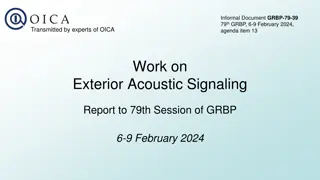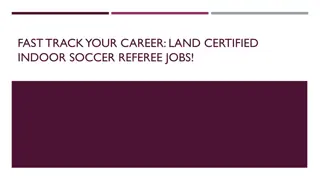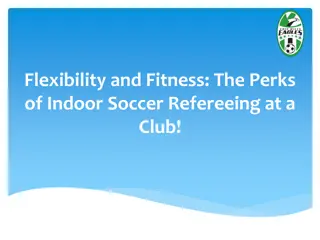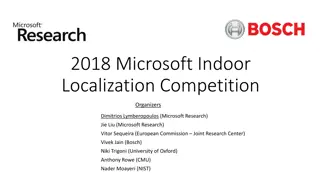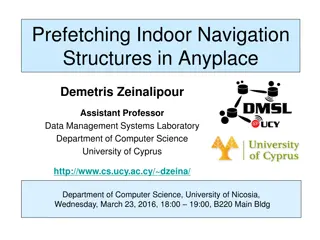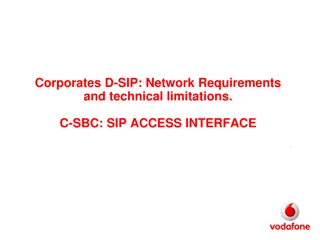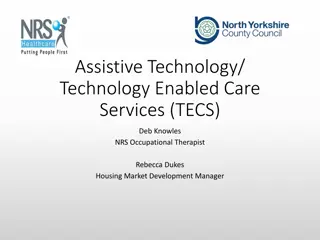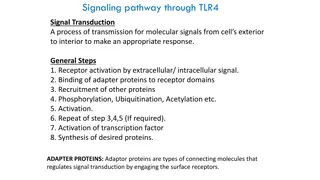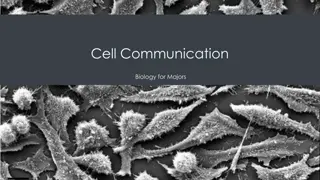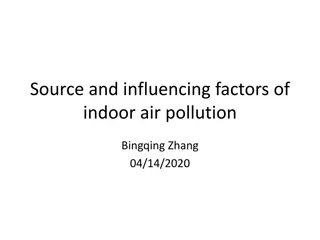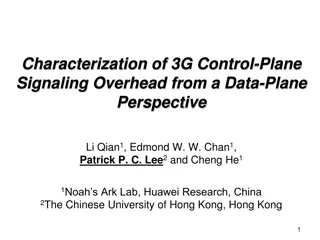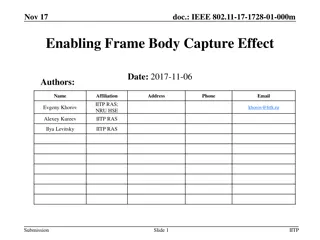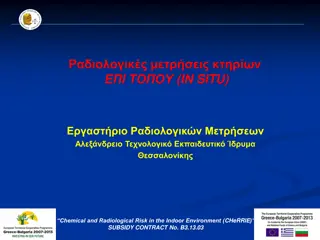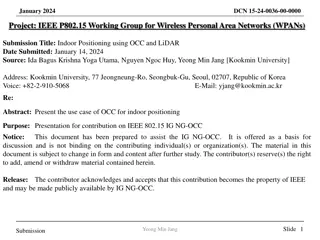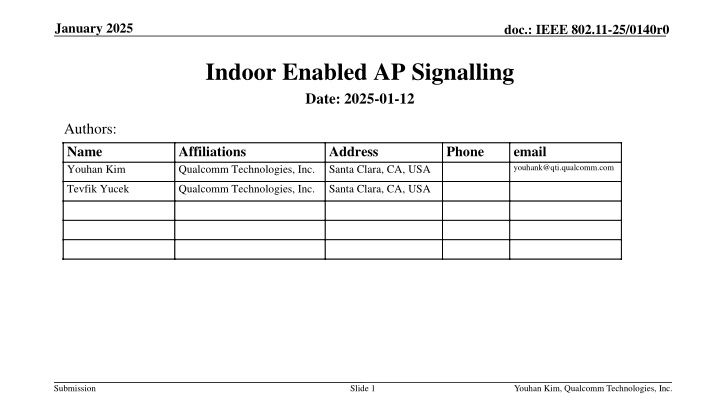
IEEE 802.11-25/0140r0 Indoor Enabled AP Signalling in the 6 GHz Band
Explore the regulatory aspects of indoor access points (APs) operating in the 6 GHz band in the context of IEEE 802.11 standards. Gain insights into C2C communication, regulatory requirements, and the implications of AP signaling for enhancing wireless networking capabilities.
Download Presentation

Please find below an Image/Link to download the presentation.
The content on the website is provided AS IS for your information and personal use only. It may not be sold, licensed, or shared on other websites without obtaining consent from the author. If you encounter any issues during the download, it is possible that the publisher has removed the file from their server.
You are allowed to download the files provided on this website for personal or commercial use, subject to the condition that they are used lawfully. All files are the property of their respective owners.
The content on the website is provided AS IS for your information and personal use only. It may not be sold, licensed, or shared on other websites without obtaining consent from the author.
E N D
Presentation Transcript
January 2025 doc.: IEEE 802.11-25/0140r0 Indoor Enabled AP Signalling Date: 2025-01-12 Authors: Name Youhan Kim Affiliations Qualcomm Technologies, Inc. Address Santa Clara, CA, USA Phone email youhank@qti.qualcomm.com Tevfik Yucek Qualcomm Technologies, Inc. Santa Clara, CA, USA Submission Slide 1 Youhan Kim, Qualcomm Technologies, Inc.
January 2025 doc.: IEEE 802.11-25/0140r0 Background In the 6 GHz band, Regulatory Info subfield (in the HE Operation element) is used to convey regulatory related information E.g., used by non-AP STAs to determine information such as the allowed max. TX power REVme D7.0 P5921 Submission Slide 2 Youhan Kim, Qualcomm Technologies, Inc.
January 2025 doc.: IEEE 802.11-25/0140r0 Background (2) must Indoor AP (a.k.a. LPI AP) is permitted to operate in the 6 GHz band without having to check for incumbent systems using database lookup E.g., Max. TX power FCC : -1 dBm/MHz (non-AP STA) Japan : 10 dBm/MHz One of the requirements is that the AP must be an indoor device E.g., cannot have weather resistant enclosure, cannot operate on battery power, etc. in case of FCC Client-to-Client (C2C) communication cannot benefit from the LPI rules as the client devices often do not meet the indoor requirement (e.g., battery operation) Examples of C2C communication: Soft AP, P2P, etc. Many regulatory bodies are enabling Very Lower Power (VLP) devices which is not subject to indoor requirement, but at much lower max. TX power FCC : -5 dBm/MHz Japan : 1 dBm/MHz Submission Slide 3 Youhan Kim, Qualcomm Technologies, Inc.
January 2025 doc.: IEEE 802.11-25/0140r0 Background (3) Japan has enabled C2C communication in the 6GHz where if a device can hear an indoor AP, then the device may transmit using TX power level higher than that allowed by VLP regulations E.g., a phone acting as a Soft AP may use 10 dBm/MHz TX power instead of 1 dBm/MHz (VLP) if the phone can hear another indoor AP (LPI AP or Indoor Standard Power AP) C2C is under consideration in other regulatory bodies as well Submission Slide 4 Youhan Kim, Qualcomm Technologies, Inc.
January 2025 doc.: IEEE 802.11-25/0140r0 Why Does an AP Need to Indicate C2C? While Japan is the only country which currently allows C2C operation, US and other countries are also reviewing C2C C2C regulations might differ between different regulatory regions, but there are largely three possibilities 1. Each end of the link can be enabled separately to use C2C power level E.g., STA2 associated to AP1 could use C2C TX power if STA2 can hear another indoor AP3 independent of whether AP1 can also hear some indoor AP 2. Both ends of the link need to be enabled by indoor AP(s) E.g., STA2 associated to AP1 may use C2C TX power only if both AP1 and STA2 can hear indoor AP(s), but not necessarily the same indoor AP(s) 3. Both end of the link need to be enabled by the same indoor AP E.g., STA2 associated to AP1 may use C2C TX power only if both AP1 and STA2 can hear the same indoor AP3 #2 and #3 require APs to advertise that the AP is enabled by another indoor AP Submission Slide 5 Youhan Kim, Qualcomm Technologies, Inc.
January 2025 doc.: IEEE 802.11-25/0140r0 Issue Observed in the Field: Devices using Linux Kernel Cannot Connect to C2C APs IEEE 802.11 has designated Regulatory Info value 3 to allow an AP to announce that it is operating under the C2C regulations Unfortunately, field tests show that APs w/ Regulatory Info = 3 are not included in the WLAN scan results in devices using Linux kernel Not a vendor specific issue, but an issue in the Linux kernel E.g., Android devices, laptops/PCs using Linux, IOT devices based on Linux Submission Slide 6 Youhan Kim, Qualcomm Technologies, Inc.
January 2025 doc.: IEEE 802.11-25/0140r0 Devices using Linux Kernel Cannot Connect to C2C APs: Impact / Current Status Because devices using Linux kernel cannot connect to C2C APs (huge interop issue), C2C APs have no other choice but to advertise themselves as a VLP AP Even if the Linux kernel is fixed , C2C capable APs would not know when all Linux based devices in the field has received the kernel update Hence, Regulatory Info = 3 (C2C) is unusable unfortunately Suppose a non-AP STA2 is capable of C2C in regions where STA2 needs to know that the AP is also C2C enabled But since C2C capable APs cannot advertise themselves as C2C APs due to the interop issue with Linux based devices, STA2 cannot use/benefit from C2C Even if STA2 is not based on Linux kernel, STA2 would not be able to benefit from C2C Submission Slide 7 Youhan Kim, Qualcomm Technologies, Inc.
January 2025 doc.: IEEE 802.11-25/0140r0 Proposed Solution High Level Spoof the AP regulatory type signaling such that Legacy devices see the C2C AP as a VLP AP Provide basic interoperability to legacy devices, albeit using lower TX power level Updated STAs can understand that the AP is in fact a C2C AP Hence, can make use of higher TX power level Submission Slide 8 Youhan Kim, Qualcomm Technologies, Inc.
January 2025 doc.: IEEE 802.11-25/0140r0 Proposed Solution Option 1 Extend the Regulatory Info subfield in the HE Operation element to 5 bits Use value 18 to designate an Indoor enabled AP Regulatory Info subfield Value Description 0 Indoor AP Current 1 Standard power AP 2 Very low power AP 3 Indoor enabled AP (deprecated) 4 - 6 Reserved 7 AP role not relevant 8 Indoor standard power AP Proposed B0 B1 B2 B3 B7 9 - 15 17 Reserved Channel width Duplicate Beacon Regulatory Info 18 Indoor enabled AP 19-31 Reserved Bits: 2 1 5 Submission Slide 9 Youhan Kim, Qualcomm Technologies, Inc.
January 2025 doc.: IEEE 802.11-25/0140r0 Proposed Solution Option 1 (cont d) Legacy clients will see value 18 as value 2 (VLP) Allows legacy devices to connect with C2C APs using VLP regulations Updated clients will understand value 18 as C2C Hence, benefit from the higher TX power allowed by C2C regulations Regulatory Info subfield Value Description 0 Indoor AP 1 Standard power AP 2 Very low power AP 3 Indoor enabled AP (deprecated) 4 - 6 Reserved 7 AP role not relevant Deprecate value 3 8 Indoor standard power AP 9 - 15 17 Reserved 18 Indoor enabled AP 19-31 Reserved Submission Slide 10 Youhan Kim, Qualcomm Technologies, Inc.
January 2025 doc.: IEEE 802.11-25/0140r0 Proposed Solution Option 2 No change to the Regulatory Info subfield i.e., keep to the current 4 bits Instead use the Transmit Power Envelope element to convey the C2C information Transmit Power Envelope element currently has six Interpretation values Submission Slide 11 Youhan Kim, Qualcomm Technologies, Inc.
January 2025 doc.: IEEE 802.11-25/0140r0 Proposed Solution Option 2 (cont d) The Additional regulatory client EIRP (PSD) interpretation is currently used only when the Regulatory Info is Indoor standard power AP REVme D7.0 P5923 Proposal is for Indoor enabled AP to Use Regulatory Info value 2 (VLP) Include TPE element with interpretation Additional regulatory client EIRP (PSD) TX power level indicated corresponds to TX power allowed by C2C regulations Non-AP STA would detect that the AP is using C2C regulations by the presence of the TPE elements with interpretation Additional regulatory client EIRP (PSD) Submission Slide 12 Youhan Kim, Qualcomm Technologies, Inc.
January 2025 doc.: IEEE 802.11-25/0140r0 Summary Current signaling for Indoor enabled (C2C) AP is unfortunately not compatible w/ significant number of legacy devices Devices based in Linux do not include APs with Regulatory Info value equal to 3 in the WLAN scan results We have proposed two options to enable Indoor enabled AP operation while keeping backwards compatibility to legacy devices Submission Slide 13 Youhan Kim, Qualcomm Technologies, Inc.
January 2025 doc.: IEEE 802.11-25/0140r0 Straw poll Which option do you prefer to fix the Indoor enabled AP signaling? Option 1 Increase the Regulatory Info subfield to 5 bits, and use value 18 to indicate Indoor enabled AP Option 2 Use Regulatory Info value 2 and include TPE element with interpretation Additional regulatory to indicate Indoor enabled AP NOTE Regulatory Info value 3 to be deprecated Submission Slide 14 Youhan Kim, Qualcomm Technologies, Inc.

